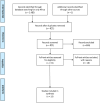Factors associated with ownership and utilization of insecticide treated nets among children under five years in sub-Saharan Africa
- PMID: 35538524
- PMCID: PMC9092763
- DOI: 10.1186/s12889-022-13347-x
Factors associated with ownership and utilization of insecticide treated nets among children under five years in sub-Saharan Africa
Abstract
Background: Insecticide-treated net (ITN) is a cost-effective means to control malaria and morbidity in under-five children. This study synthesizes the factors associated with using the ITN as a malaria prevention tool in sub-Saharan Africa.
Methods: There was an advanced search of four electronic databases, including PubMed Central, CINAHL, EMBASE, and Google Scholar, and identified articles between 2016 to April 2021. Following the title, abstract and full-text reading, 13 articles were deemed appropriate for this review. All the researchers developed, discussed, and accepted a matrix to extract relevant information from the studies. A convergent synthesis was adopted and allowed for integrating qualitative, quantitative, and mixed-method studies and transforming them into qualitative findings.
Results: Household and caregiver related factors that influenced utilization of the ITN were, Household heads having two or more sleeping places, a knowledge that ITN prevents malaria, the presence of hanging ITNs, high literacy, living female-headed households, birth spacing, unmarried mothers, and antenatal clinic attendance promoted utilization. Perceived malaria risk was a critical determinant of ITN ownership and utilization. Some factors that hindered the use of the ITN included hotness of the weather, absence of visible mosquitoes, cost, inadequate number, rooms designs, unaffordability, insufficient knowledge on causes of malaria, and poor attitude to use. Specific ITN factors that hindered use were color, chemicals use, odor, and shape.
Conclusion: It is important to use integrated multi-sectoral and culturally appropriate interventions to encourage households to prioritize and utilize the ITN in under-5 children.
Keywords: Insecticide Treated Bed Net; Malaria; Prevention; Treatment; Under Five Children; Utilisation.
© 2022. The Author(s).
Conflict of interest statement
The authors declare they have no conflict of interest in conceptualizing, drafting, and publishing this manuscript.
References
-
- WHO. Roll back malaria progress & impact series: a decade of partnership and results. Geneva: WHO; 2011.
-
- Strategy for malaria elimination in the Greater Mekong Subregion (2015–2030). [press release]. Geneva: WHO2015.
-
- WHO. World malaria report 2015. Geneva: WHO; 2016.
-
- Sachs J, Malaney P. The economic and social burden of malaria. Nature. 2002;415(6872):680–5. 10.1038/415680a. - PubMed
Publication types
MeSH terms
Substances
LinkOut - more resources
Full Text Sources
Medical
Miscellaneous


